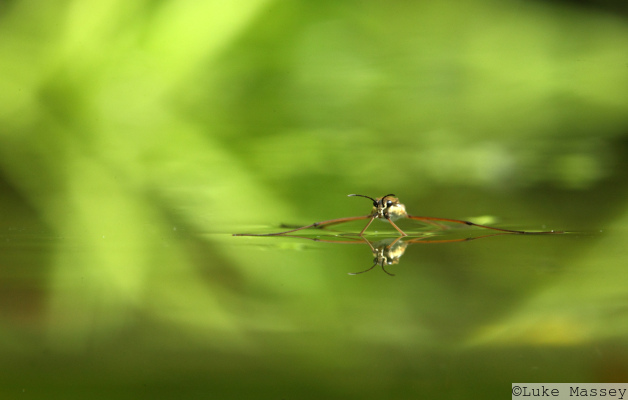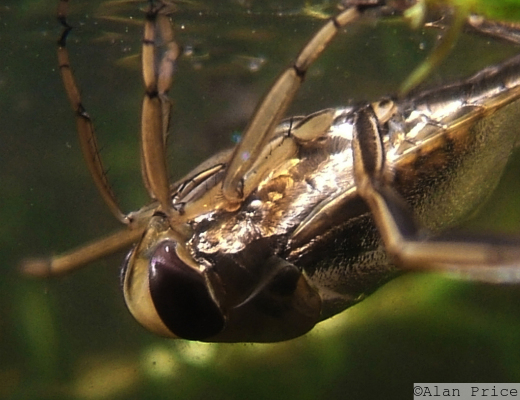Common aquatic invertebrates
<
>


 Status
Status Common
Common Widespread
Widespread Season
Season All Year Round
All Year Round Kneel or crouch close to the canal and study the water’s surface and just below it, looking for tiny aquatic invertebrates
During the summer, the water on the Montgomery Canal comes alive with insects. Look at the surface of the water and just below it and you’ll see a trio of the most well-known and easily identifiable, and familiar from garden ponds.
First off is the Common Pondskater (Gerris lacustris). One of nine species of pond skater in the UK, all measuring 1cm-2cm in length, they ‘skate’ around the surface of the water in ponds, lakes and slow-moving rivers and other waterways, feeding on smaller insects which they stab with their sharp mouthparts. Around from April to November, these impressive predators have water-repellent hairs on the bottom of their feet, enabling them to walk on the surface film. They then hunt by detecting vibrations in the film.
Next is the Water Boatman (Notonecta glauca) or Common Backswimmer. Another fearsome predator, it hunts other insects, tadpoles and small fish, using its oar-like legs to swim upside-down and hunt unsuspecting prey. Also sensing vibrations in the water, it moves at great speed and stabs victims with its mouth part, injecting them with a toxic saliva. Be careful if handling this insect as it can give a nasty nip.
Last but not least, the Whirlygig Beetle (Gyrinus substriatus) can be seen whirling in circles on the surface of the water, or shooting across the surface to grab its next meal. These small black beetles have short back legs that resemble paddles.
First off is the Common Pondskater (Gerris lacustris). One of nine species of pond skater in the UK, all measuring 1cm-2cm in length, they ‘skate’ around the surface of the water in ponds, lakes and slow-moving rivers and other waterways, feeding on smaller insects which they stab with their sharp mouthparts. Around from April to November, these impressive predators have water-repellent hairs on the bottom of their feet, enabling them to walk on the surface film. They then hunt by detecting vibrations in the film.
Next is the Water Boatman (Notonecta glauca) or Common Backswimmer. Another fearsome predator, it hunts other insects, tadpoles and small fish, using its oar-like legs to swim upside-down and hunt unsuspecting prey. Also sensing vibrations in the water, it moves at great speed and stabs victims with its mouth part, injecting them with a toxic saliva. Be careful if handling this insect as it can give a nasty nip.
Last but not least, the Whirlygig Beetle (Gyrinus substriatus) can be seen whirling in circles on the surface of the water, or shooting across the surface to grab its next meal. These small black beetles have short back legs that resemble paddles.
The Whirlygig Beetle is unmistakeable in its movements, making it fairly simple to identify. The Common Pondskater has brownish-black long legs and is also distinctive because of its movements, though it’s sometimes confused with the smaller, thinner Common Water-Measurer or chunkier shorter-legged Water Cricket. The Water Boatman is one of many in the Corixidae family and it is called the Common Backswimmer to distinguish it from the Lesser Boatman which does not swim upside down.


